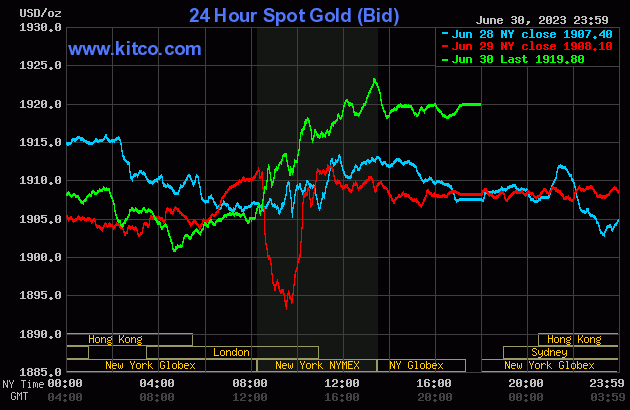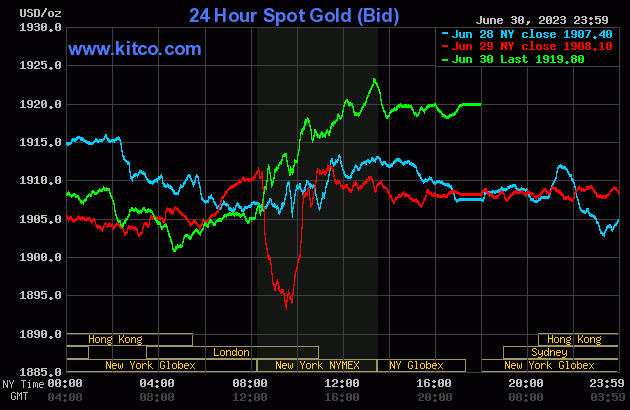
Here's why gold price is above $1,900 despite two looming rate hikes
After testing $1,900 an ounce, gold has come out on top, saving itself from a more significant selloff if prices dropped below this psychologically important level.
Gold is wrapping up the second quarter down more than $80, the worst performance since the third quarter of last year. At the time of writing, August Comex gold futures were trading at $1,925.80 an ounce, up 0.41% on the day.
But there have been some positive signs. Gold's downtrend has been slow and steady and not sudden and steep. Also, it held the $1,900 an ounce level.
"I'm surprised by the resilience in gold given the moves in the U.S. bond market – still, for now, I question if growth equity (such as the NAS100) continues to march higher if U.S. bond yields are trending higher, and how this offers the USD tailwinds," said Pepperstone's head of research Chris Weston.
Federal Reserve Chair Jerome Powell's message of at least two more rate hikes this year filtered through the market, weighing gold down and pushing the U.S. dollar higher.
But the fact that prices have not fallen below $1,900 an ounce shows resilience in the gold market, with increasing sentiment that the equity rally won't last.
"While an environment in which interest rates are likely to continue rising is unhelpful for this non-yield bearing asset, investors are still not convinced of the bull case for equities, especially with some countries potentially already in recession," said Kinesis Money market analyst Rupert Rowling.
What's holding gold up?
If the $1,900 was taken out, OANDA senior market analyst Edward Moya told Kitco News that there would be significant technical selling.
But one of the reasons gold held up was because markets are yet to price in two rate hikes by the Fed, Moya pointed out. According to the CME FedWatch Tool, there is a nearly 90% chance of a 25-basis-point rate hike in July and a 70% chance of another pause in September.
"Will inflation prove stickier, and will the Fed deliver two more rate hikes? Is it being priced in yet? No," Moya said. "Today's PCE data showed that inflation is cooling, but barely."
Right now, gold is not very attractive, but it could have its big moment when the market reassesses how much more aggressive the Fed will have to be to bring down inflation, Moya added.
"More Fed rate hikes are normally bearish for gold. But given the positioning in the market, we could see a stock market selloff and a return of strong demand for the safe haven," he said. "That is not an environment where gold will be collapsing."
Moya is anticipating range-bound trading in the short term, with risks to the downside if gold drops below $1,900 an ounce. "If we break below that level, it could get ugly. But I don't think it is going to happen," he said.
This type of trading might be enough to keep gold from falling lower. But at the same time, significant gains are not likely in the short term, said TD Securities global head of commodity strategy Bart Melek.
"At 4.6%, the U.S. May y/y core PCE is slightly lower than expected, and with weaker personal May personal spending, the market drove yields lower," Melek said. "With that, the USD dropped, and gold bounced convincingly above $1,900/oz. This reduces the risk of a drop down to the 200d ma, for now."
With more evidence that inflation in the U.S. might have peaked, the selloff in gold has likely run its course, Walsh Trading co-director Sean Lusk told Kitco News. "But gold better holds this level," said Lusk. "Gold needs to take out $1,966 to turn bullish."
The precious metal will move higher only after the equity market reverses its rally, Lusk added. "If the stock market keeps chugging, there will be less demand for gold. Stock market rallies will bring up inflation, and that will keep the Fed raising rates, with the U.S. dollar being the winner in this," he said. "Don't think the stock market will extend here as we get to Q3."
The U.S. dollar's strength is why rallies in gold have been sold, Lusk added.
If gold drops below $1,900 an ounce, investors should pay attention to $1,850-$1,814 levels. "If we can't hold that, then a drop to $1,720 is possible. That's a bear scenario," he said.

Next week's data
Monday: ISM manufacturing PMI
Thursday: U.S. jobless claims, ADP nonfarm employment, ISM services PMI
Friday: U.S. nonfarm payrolls
By
Anna Golubova
For Kitco News
Tim Moseley
